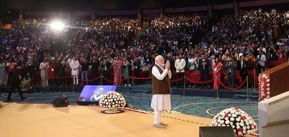
Space Milestone: ISRO’s heaviest-ever rocket GSLV Mark-III carrying a crew module lifts off during a test flight from Sriharikota on Thursday. PTI
Shubhadeep Choudhury
Tribune News Service
Sriharikota, December 18
India today tasted twin success in the arena of space exploration by successfully launching its heaviest rocket (GSLV Mark-III) yet and testing an unmanned crew module weighing 3.73 tonne.
The development of the launcher (Geosynchronous Satellite Launch Vehicle Mark-III) will make India self-reliant in terms of launching satellites into space.
Two weeks ago, the Indian Space Research Organisation (ISRO) had hired the services of European company Arianespace to launch communications satellite GSAT-16 weighing 3.18 tonne into space.
The crew module lifted by GSLV Mark-III today weighed 60 kg more. GSLV Mark-III can also make India an important player in the global marketplace of launch service providers.
The successful re-entry of the crew module into earth’s atmosphere will help India join a select club of nations that have sent astronauts into space. Unnikrishnan Nair, project director of the Crew Module Atmospheric Re-entry Experiment (CARE), said the module (2.7 m high with 3.1 m base diameter) fell into the sea "within five nautical miles of its intended impact point".
After impacting the sea near the Andaman and Nicobar Island, the module released a dye that made the colour of the water around it look deep green.
A Dornier aircraft of the Indian Coast Guard located the module and passed on the information to the ship deployed for salvage. A Chetak helicopter took off from Coast Guard ship "Samudra Pehredar" for inspection of the module.
After receiving the green signal from the helicopter, the ship started moving toward the module.
"Besides the dye, the module was also equipped with a GPS and a beacon to help locate it. All three systems have worked beautifully," Nair said.
The main challenge before Nair and his teammates was that the crew module did not disintegrate due to excessive heat encountered during re-entry into earth's atmosphere (that's how Kalpana Chawla and six others had died in the Columbia space shuttle disaster). Separated at 126 km above earth (5.3 minutes after the rocket was fired from the second launch pad at Sriharikota at 9.30 am), the crew module took 21 minutes to fall into sea.



























